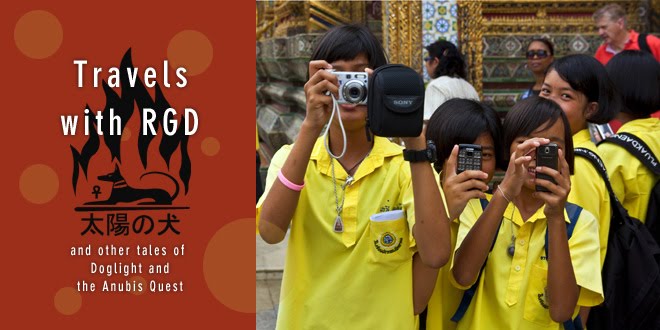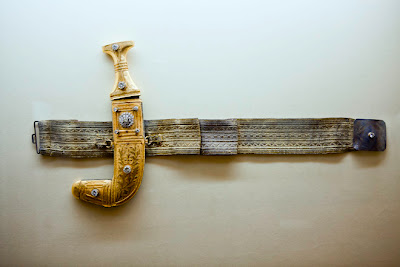 All material including photographs are ©2010 Ronald Dunlap / Doglight Studios
All material including photographs are ©2010 Ronald Dunlap / Doglight StudiosThe morning was a little overcast, and I had a little trouble getting out of bed. After a long shower, I dressed, got my equipment packed, and headed out the door. Down on the fifth floor, I found a seat in the cafe, stashed my stuff, grabbed a plate, and headed for the breakfast buffet. It was going to be a long day and I needed all the fuel I could pack away, so I went back twice to shovel it in.
It is a good three-and-a-half-hour drive south to the necropolis of Khmun (Hermopolis Magna). Today, this large and dispersed site is known as Tuna el Gebel. Located in Middle Egypt in the Al Minya Governorate, it was the northern boundary of Akhenaten's capital city, Armana. One of the Boundary Stele of the Armana is located here but is now obscured by a glass booth whose purpose is to prevent further wind damage to the carving but which makes it hopelessly unattractive.
Magdy determined that the Desert Road was the best route to get to the necropolis. I was a little leery, as neither of us had been that way before and the place is in the middle of nowhere, where road signage is practically non-existent. It was a long, hot ride, and as expected we drove past the turn-off. We were 30 km past when we stopped at one of the numerous police checkpoints and were told that we had come too far. After hanging a U-turn, we headed back north until we found the dirt road that led to our destination. Ten minutes down the dirt road we came to a crossroads and asked a young shepherd, whose sheep were crossing the road, where Tuna Gebel was. He pointed north.
When we reached the little town of Mallawi, we knew that the shepherd had been having fun with us. We reversed direction and headed back south until we found Tuna Gebel.
Mr. Mohamed Wahballa Abdel Aziz, the inspector who had been assigned to show me around, was waiting at the chain barrier when we pulled up. It was hot as blazes when I got out of the car. Magdy said he'd find a cool spot to park the car and that he'd be waiting with the guard when I was done.
Mohamed led the way down the sandy path to the Tomb of Petosiris. It is a well-preserved tomb in the shape of a Late Period temple, very reminiscent of the Temple of Dendera. I was pleasantly surprised at the level of decoration, which looked to be a combination of Old Kingdom and Ptolemaic influences. I loved seeing the bas-relief figures dressed in togas.
Built for Petosiris, high priest of Thoth, it also became the final resting place for members of his extended family.
While my guides rested in the shade of the temple, I spent 40 minutes shooting the place. It was semi-dark inside, so I had to use my tripod to capture the essence of this late-period temple. When I'd finished, I called out "Halas" ("finished" in Arabic), and my guides knew we were off.
Our next stop was the Tomb/Chapel of Isadora. A young beautiful woman of means, Isadora lived in the second century AD. She fell in love with a soldier who wanted to marry her; but her father felt that the young man was below her station and forbad the marriage. Undeterred, she decided to elope, and in attempting to reach her future husband on the other side of the Nile, she unfortunately drowned.
Filled with a great sense of guilt and remorse, her father built an elaborate tomb to do a better job of guarding his daughter in the next life than he'd done in this one. Her mummified remains still linger here and can be seen in her glass-encased resting place. Although she's not as beautiful as she once must have been, there is still something about her and her story that even today generates a cult following.
Next on the itinerary were the massive catacombs that are like a small city under the necropolis. Dedicated to the God of Knowledge, the catacombs are filled with thousands, if not hundreds of thousands, of mummified offerings. The offerings of mummified baboons and ibises were dedicated to Thoth, because he often appeared in their material form.
My main Egyptological interest is in Anubis, the god of mummification and protector of tombs, typically represented as having the head of a dog. The vast majority of archaeologists conclude that his head is that of a jackal, but I believe that it is the head of a dog, because he is always wearing a collar, and jackals don't.
There are canine mummies, but I have yet to find a large concentrated burial area of dogs, even though there are ancient references of them existing. Down in the catacombs, Mr. Aziz mentioned that there is a dog cemetery not too far from here at North Minia, near Bani Mazar City, but unfortunately that will have to wait until my next trip to Egypt.
I spent a good hour in the catacombs, shooting with the help of my tripod and cable release. When I finished, we exited the cool, underground chambers into the blast-furnace of late afternoon heat.
We were invited into one of the guest houses for cool drinks and a little rest before we hit the road back to Cairo. There was also a tour group of Italian women in the rest house.
It was a long, hot ride back, and I was worn out by the time we got back to the Hilton. I staggered into the elevator and up to my room. I unloaded my stuff, then ordered dinner and watched TV until room service delivered my spaghetti and soda. Then I went to bed and fell asleep with the TV on.







































































